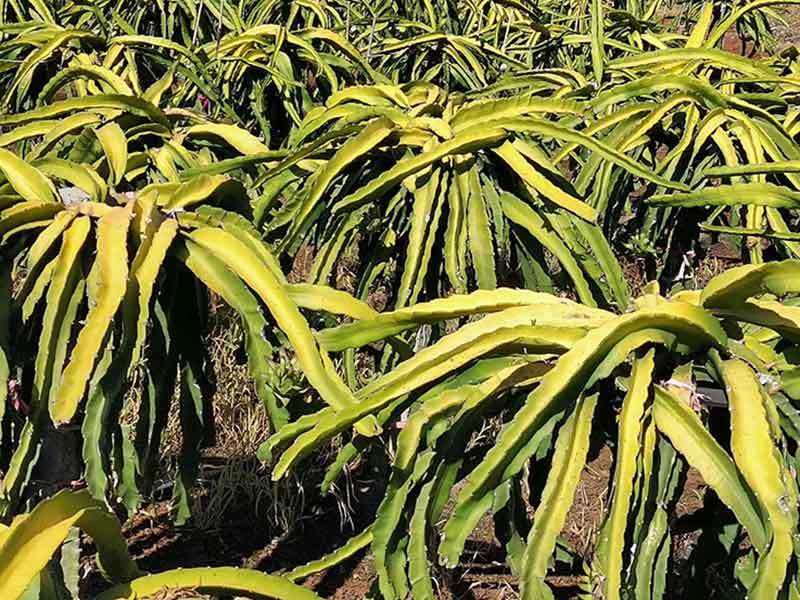Why Is My Dragon Fruit Plant Turning Yellow?
Introduction
Why my dragon fruit turn yellow? When chlorophyll starts to break down, dragon fruit plants will turn yellow. Yellowing will affect the look and health of the plant. You should quickly identify the cause of dragon fruit turning yellow and get them back on track.
Why Is My Dragon Fruit Plant Turning Yellow?
Natural Aging: As your dragon fruit plant matures, it will inevitably go through a shedding of older growth, which is normal. You should prune off dead leaves and stems. Ensure healthy and optimal growth. The plant will focus its energy on producing new foliage.
Environmental Factors: Excessive light exposure or sunburn may cause leaves to yellow and even curl up. Temperature stress or fluctuations may also cause yellowing in your dragon fruit plant. Pay attention to the temperature where you keep your plant. Improper watering practices can lead to dragon fruit leaves turning yellow.
Nutritional Deficiencies: Dragon fruit plants need access to certain essential nutrients. For example, nitrogen, iron and magnesium. If your plant is not getting enough of these vital elements, it will start to show signs of deficiency. Yellowing or wilting leaves, reduced growth rate and stunted blooms are symptoms.
Pest and Disease: Mealybugs, aphids and scale insects are common pests. They feed on the sap and cause discoloration in the leaves. Dragon fruit plants are also prone to diseases. For example, root rot and fungal infections. Brown or yellow spots on the leaves indicate fungal infections. For example, rust or mildew.
Remedial Actions for Dragon Fruit Plant Turning Yellow
Adjusting Environmental Conditions
Dragon Fruit Sunburn Treatment: You should provide proper shade and shelter. Dragon fruits need a specific amount of sunlight and air flow. To avoid overexposure, use curtains or indoor plants to provide shade and shelter from the elements.
Maintaining Consistent Temperatures: Dragon fruit plants prefer temperatures between 68-86°F (20-30°C). Take extra caution during extreme weather conditions. Make sure your dragon fruit is in a well insulated area.
Fine-tuning Watering Practices: Check the moisture levels with a moisture meter or by inserting your finger into the dirt. Water your dragon fruit plant when the top 2-3 inches of soil is dry.

Nutritional Management
You can test soil pH levels and nutrient content of the soil. You can use a fertilizer specifically formulated for cacti and succulents. Feed your dragon fruit plant once every two weeks during spring and summer. Once every four to six weeks in fall and winter. Avoid over-fertilizing as this could lead to root rot.
Amending the soil with organic matter will provide nutrients for your plant. For example, compost or aged manure. Make sure the soil has good drainage. Mulch around the base of the plant to help retain moisture. Regularly check the pH levels in the soil and adjust accordingly. Test the soil for nitrogen levels and fertilize if necessary.
Pest and Disease Control
Natural Remedies: You should take action right away if you detect an infestation or infection on your plant. You should use garlic and other natural ingredients which have pest-repelling properties. For plant diseases, you can use a fungicide or neem oil to combat the infection.
Attracting beneficial insects can help keep pests in check. For example, ladybugs, lacewings and hoverflies. To attract these beneficial insects to your garden or patio container, plant flowers around your dragon fruit plant that bloom throughout the growing season.
Chemical Options: If organic treatments don’t help with your dragon fruit plant yellowing issue, then you may need to consider chemical options as a last resort. Always follow the instructions on the label carefully when using any kind of pesticide or herbicide. Ensure you’re using it in the right dosage.
When you bring a new dragon fruit plant home, properly quarantine the plant for a few weeks. Then, introduce it into your garden or patio container. Inspect the plant carefully and discard any dead or decaying parts. Treat the plant with a chemical or natural insecticide if you find any signs of pests or diseases. Wait two weeks before introducing it.
Pruning and Trimming
Removing Affected Parts: Another possible cause of yellow dragonfruit plant is poor pruning and trimming practices. Trim away any dead, diseased, or dying leaves or stems after identifying these parts. Take care not to damage the healthy tissue in the process.
Stimulating New Growth: You should trim certain areas to stimulate new growth and recovery. For example, prune any suckers that grow close to the base of the plant or trim away stems that don’t bear fruit anymore. Your dragon fruit plant will recover from yellowing and return to its healthy green color.
Selecting Disease-resistant Plants
Selecting healthy plants from the start can help prevent illnesses. For example, dragon fruit turning yellow after flowering. When shopping for dragon fruit plants, choose disease-resistant cultivars whenever possible. Inspect the leaves and stems of the plant carefully for signs of pests or disease.
Purchase certified disease-free plants from a reputation nursery. Certified plants have been inspected and tested for certain diseases. Read the label carefully for information about the best growing conditions.
Conclusion
Why is my dragon fruit yellow? If your dragon fruit plant is turning yellow, there are a few possible explanations. Review the steps listed above and take corrective action if you have already run into this issue. While it can be disheartening when a plant turns yellow. With proper care and attention, your dragon fruit plant will recover quickly!

